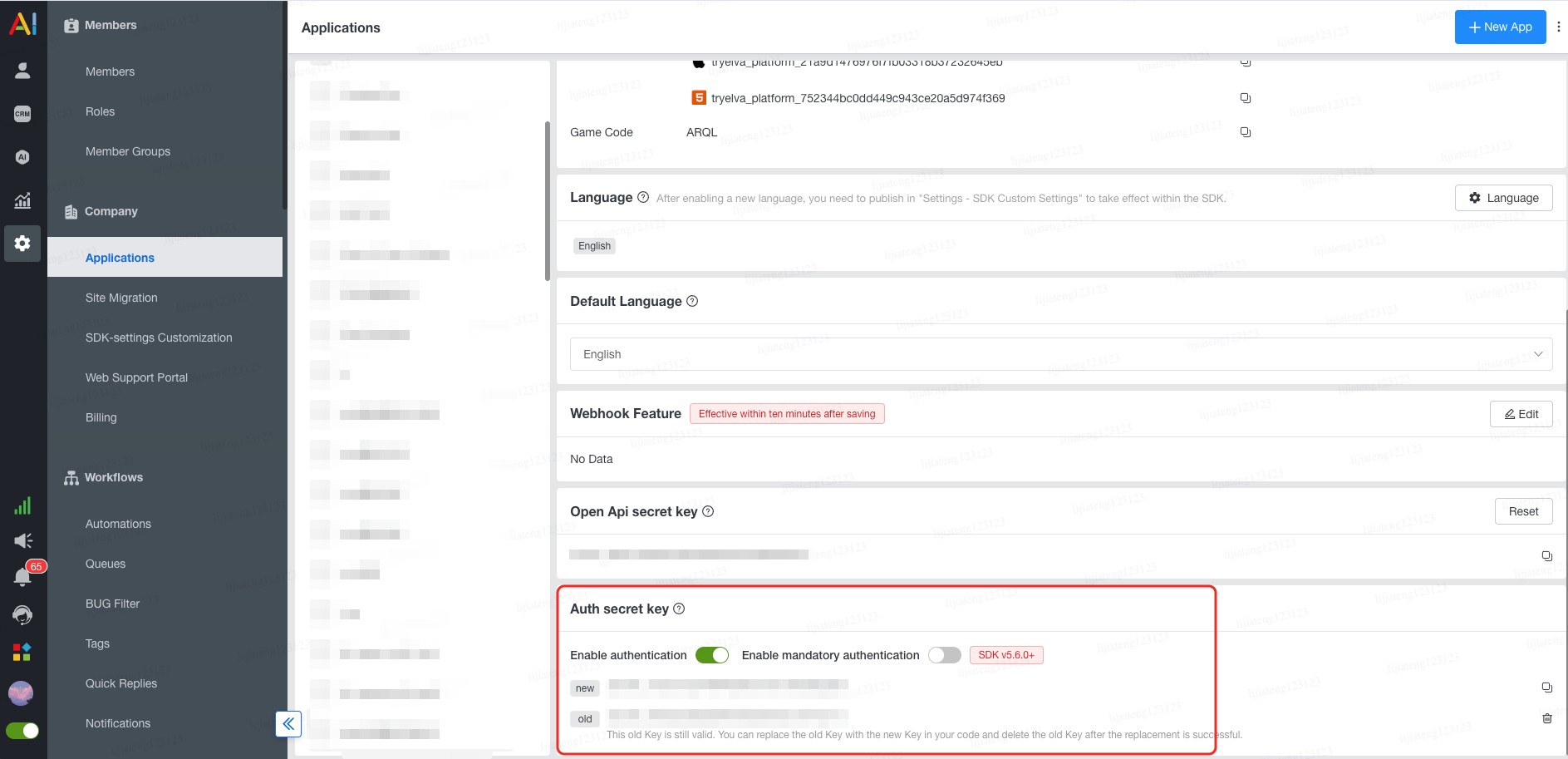# User Identity
When users log in or log out of the app, make sure to synchronize the status with AIHelp to confirm or reset the user identity.
Note
Please ensure that the userId provided to AIHelp is a unique and valid value.
Using invalid values for userId, such as an empty string (""), "null", 0, or -1, may lead to issues with customer support functionality.
# API
# login()
When users log into the app, synchronize the user ID with AIHelp so that we can generate a identity token for them.
AIHelpSupport.login("THIS IS YOUR USER ID");
Alternatively, you can achieve other capabilities by configuring LoginConfig, such as other user information, enterprise-level identity authorization, etc.:
let userConfig = {
userName: "AIHelper",
userTags: "recharge,suggestion",
applicationVersion: 'your_app_version',
customData: JSON.stringify({
key: 'value'
})
};
let loginConfig = {
userId: "THIS IS YOUR USER ID",
userConfig: userConfig
}
AIHelpSupport.login(loginConfig);
It's worth noting that when Enterprise Authentication is enabled, the applicationVersion in userConfig is mandatorily required.
# logout
When users log out, call this method to clear the current logged-in user information to ensure the accuracy of the guest identity after logging out.
AIHelpSupport.logout();
# URL
Or, you could implement the same function by the URL scheme:
<script>
let domain = "THIS IS YOUR APP DOMAIN";
let appId = "THIS IS YOUR APP ID";
let entranceId = "THIS IS YOUR ENTRANCE ID";
(function () {
let baseUrl = `https://${domain}/webchatv5/#/${appId}`;
let params = `entranceId=${entranceId}&userId=${your_user_id}&userName=${your_user_name}&userTags=${your_user_tags}&customData=${encodeURIComponent(JSON.stringify({key:"value"}))}`;
let url = `${baseUrl}?${params}`;
window.open(url);
})();
</script>
# Event
# Logging in
You can register the userLogin event to keep track of the logging in status for current user:
AIHelpSupport.registerAsyncEventListener("userLogin", function(jsonData) {
// `jsonData`: { "code": 1, "message": "Success" }
});
The code field for jsonData can be one of:
1for success;-1for invalid user id;-2for failure, check themessagefield for more information;
# Authentication
When Enterprise Authentication is enabled in the AIHelp admin panel,
the enterpriseAuth event will be triggered when login API is invoked.
And you should register the event and authenticate the user, and then pass the retrieved user token back to us via the ack callback.
AIHelpSupport.registerAsyncEventListener("enterpriseAuth", function(jsonData, ack) {
ack("{'token':'your async token'}")
});
For compatibility purposes, the data passed back to AIHelp should be in JSON format. The user token should be stored under the key token.
# Definition
# loginConfig
- Type:
object - Details: Required. Encapsulation of optional configuration items for login.
# userId
- Type:
String - Default:
A random number generated by the user's device - Details: Required. Unique user identifier, cannot be an empty string, 0, or -1.
# userConfig
- Type:
UserConfig - Default:
null - Details: Optional. User information configuration items, including username, server ID, user tags, and other custom data. Besides logging in, you can also call updateUserInfo API to update user information whenever you need.
- Code example:
let userConfig = { userName: "AIHelper", userTags: "recharge,suggestion", customData: JSON.stringify({ key: 'value' }) }; let loginConfig = { userId: "THIS IS YOUR USER ID", userConfig: userConfig } AIHelpSupport.login(loginConfig);
# Other
# Enterprise Authentication Flow
To maximize security, you can handle user identity authentication logic on your own server — known as Enterprise Authentication.
Enterprise authentication is a server-side verification process; the SDK and game client do not hold any secret keys.
The sequence of enterprise authentication is as follows:
Enable enterprise authentication and obtain the secret key from the AIHelp admin panel:

The client calls the SDK
loginAPI;- When Enterprise Authentication is enabled, the
applicationVersioninuserConfigfor theloginAPI is mandatorily required.
- When Enterprise Authentication is enabled, the
The SDK triggers the Enterprise Authentication event, and the client receives a callback. Then it sends a request to the game server to verify the player's identity;
The client receives the server's response and returns the token issued by the server to the SDK via the
ackcallback inside the enterprise authentication event;The SDK uses the received token to request the AIHelp server. The server will verify the token:
- For verified users, AIHelp will mark them as authenticated in the backend and allow normal login;
- For unverified users, depending on whether Force Authentication is enabled, AIHelp will:
- Block the login request and return a failure response to prevent further unauthorized requests;
- Mark the user as unauthenticated in the backend without affecting their ability to submit support tickets.
# Token Generation Rules
During the enterprise authentication process, you need to obtain the secret key from AIHelp and issue a token for the user on your server, based on the following rules:
- Use the secret key provided by AIHelp, available in Backend Settings - App Settings - Auth Secret Key;
- Use the HS256 signing algorithm; a recommended token validity period is 24 hours;
- Generate a standard-format JWT, with the following claims:
{
"exp": 1718868267, // Expiration timestamp (in seconds)
"iat": 1718781867, // Issued-at timestamp (in seconds)
"nbf": 1718781867, // Not-before timestamp (in seconds)
"iss": "xxxx", // Custom issuer
"jti": "947b3086-9aad-40d8-b5cf-752c9294f392" // UUID
}
sub(required): Unique user identifier, same as theuserIdused in the login APIiss(required): Recommended to use your company's English name or abbreviationjti(required): Recommended to use a UUIDexp(required): Expiration timestamp (in seconds), recommended to set to current time + 24 hoursiat(optional): Issued-at timestamp (in seconds), set to current timenbf(optional): Not-before timestamp (in seconds), recommended to set to current time
You can refer to the sample code we provide (opens new window) for token generation and validation.
← Help Center User Info →
